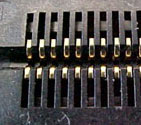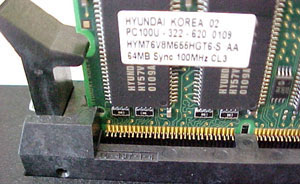 By its' very
precise nature, memory can be influenced by its surroundings in ways which can
equate to decreased performance and reliability. A few obvious influencers are
of course module temperature and clock frequency, but at lest one other factor
surfaced during our tests of a few SDRAM sticks.
By its' very
precise nature, memory can be influenced by its surroundings in ways which can
equate to decreased performance and reliability. A few obvious influencers are
of course module temperature and clock frequency, but at lest one other factor
surfaced during our tests of a few SDRAM sticks.
Interestingly, the way memory modules are inserted into the DIMM slot, the
quality of the DIMM socket, and the quality of the module PCB can all influence
the performance of memory very substantially.
In the case of the Ramcheck the differences
in memory module PCB quality were emphasized rather than shortcoming in the
Yamaichi 168-pin socket (IC438-1-1). What we observed were seemingly unrelated
differences in a particular stick of memory that would alter the results of the
Ramcheck's tests for no apparent reason.
The only change in the test procedure was
the removal and reinsertion of the memory module into the DIMM socket.
Otherwise, all settings were left the same. Still, some 168-pin modules would
generate outright errors, while others could be tested in the same fashion and
return entirely consistent results from test to test.
What would be causing a few 168-pin modules
of memory to generate such inconsistent results?
 The answer as we
discovered, was due to the minute difference in the tolerances of the underlying
PCB, the green coloured fiberglass backer with copper trace lines supporting the
TSOP-II memory chips. Apparently the differences in conductivity between the
connector pins and the socket pins is to some degree relative to the force
between the two.
The answer as we
discovered, was due to the minute difference in the tolerances of the underlying
PCB, the green coloured fiberglass backer with copper trace lines supporting the
TSOP-II memory chips. Apparently the differences in conductivity between the
connector pins and the socket pins is to some degree relative to the force
between the two.
In some instances we were able to recreate
memory instability by just installing the memory module in the socket with a
small force towards one side. Depending on the tolerances of the PCB, and to
what thousandth of an inch the PCB was thick, or long, there would be minor
differences in the electrical conductivity between socket and pin.
In a few instances of generic memory, the
variances in electrical conductivity were large enough to cause the memory
module to fail the test with error bits. By the same token, the problematic
parameters were so variable that installing the same stick with slight force
toward the other side of the socket could cause no issues whatsoever.
A simple check for quality:
It was interesting to see the results of
lower quality PCB on the performance and stability of a stick of SDRAM and the
only advice we can give you is as follows. Look closely at the left, right, and
bottom edges of the PCB. If it has been machined flat you are probably looking
at some decent parts. If on the other hand it is not totally flat, or appears as
though the PCB may have been scored and broken clean, then you are probably
looking at a lower quality part. Keep in mind that is a rough guide line and won't
hold true for ever instance. Also, since there is no quick and easy way to
measure the thickness of the PCB and gold plated copper trace lines there is no
real simple way to gage quality there.
Of course the other end of the spectrum is
true to. If the motherboard manufacturer uses a less expensive socket with lower
tolerances or less than ideal gold plating on the contact then you may also be
fighting some problems that not stick od DRAM will be about to
circumvent.
